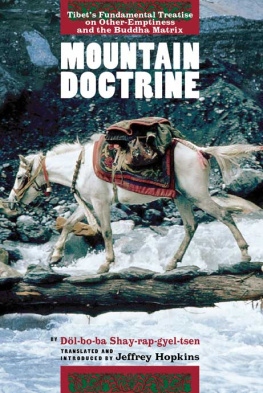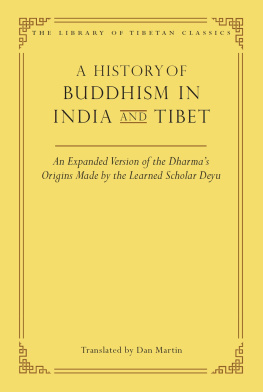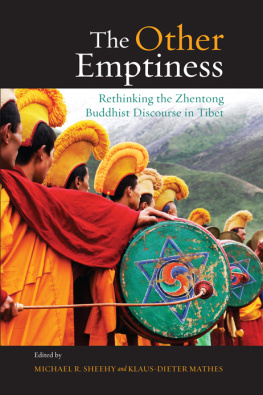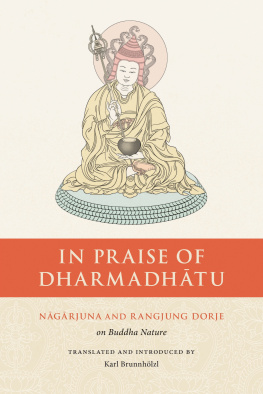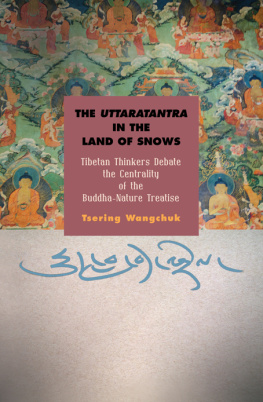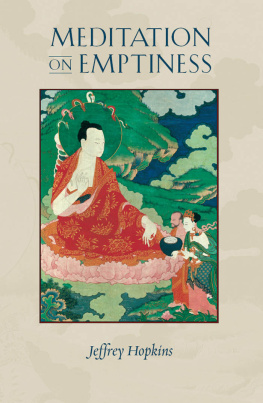The Mountain Doctrine of Dolpopa Sherab Gyaltsen is one of the great monuments of Tibetan philosophical literature. For nearly 700 years Dolpopas work has been a fundamental source of inspiration for practitioners attracted to the definitive meaning of the Buddhas teachings. Jeffrey Hopkins deserves our sincere gratitude for making this profound message finally available to students of the Dharma outside Tibet.
Cyrus Stearns, author of The Buddha from Dolpo
It is only fitting that Hopkins, who wrote the single most important monograph on the central Buddhist concept of emptiness, should have undertaken to translate Dolpopas text for the first time. Few others would have been qualified for this challenging task.... Contains mountains of material for deep philosophical reflection and once again drives home the point that conceptual differences exist even between awakened masters, and that regardless of doctrinal differences, their fine-tuned teachings can point the way to enlightenment. A magnificent volume.
Georg Feuerstein, PhD, author of The Deeper Dimension of Yoga
This monumental publication will serve as an invaluable source on emptiness and buddha nature for generations to come.
Buddhadharma: The Practitioners Quarterly
ABOUT THE BOOK
Translated here for the first time into any language, Mountain Doctrine is a seminal fourteenth-century Tibetan text on the nature of reality. The author, Dol-bo-ba Shay-rap-gyel-tsen, was one of the most influential figures of that dynamic period of doctrinal formulation, and his text is a sustained argument about the buddha-nature, also called the matrix-of-one-gone-thus. Dol-bo-ba recognizes two important types of emptiness self-emptiness and other-emptiness and shows how other-emptiness is the actual ultimate truth. He justifies this controversial formulation by arguing that it was the favored system of all the early outstanding figures of the Great Vehicle. The translators introduction includes a short biography of Dol-bo-ba and an exposition of nine focal topics in his religious philosophy.
Note: The hardcover edition of Mountain Doctrine includes a Detailed Outline in Tibetan that is omitted in the eBook edition.
Sign up to receive weekly Tibetan Dharma teachings and special offers from Shambhala Publications.

Or visit us online to sign up at shambhala.com/edharmaquotes.
Mountain Doctrine
Tibets Fundamental Treatise on Other-Emptiness and the Buddha-Matrix
Dl-bo-ba Shay-rap-gyel-tsen
Translated and Introduced by Jeffrey Hopkins
Edited by Kevin Vose
Snow Lion
Boulder
2017
Snow Lion
An imprint of Shambhala Publications, Inc.
4720 Walnut Street
Boulder, Colorado 80301
www.shambhala.com
Copyright 2006 Jeffrey Hopkins
All rights reserved. No portion of this book may be reproduced by any means without prior written permission from the publisher.
Library of Congress Cataloging-in-Publication Data
es-rab-rgyal-mtshan, Dol-po-pa, 12921361.
[Ri chos es don rgya mtsho es bya ba mthar thug thun mo ma yin pai man ag. English]
Mountain doctrine : Tibets fundamental treatise on other-emptiness and the Buddha-matrix / Dol-bo-ba shay-rap-gyel-tsen ; translated and introduced by Jeffrey Hopkins ; edited by Kevin Vose.
p. cm.
Includes bibliographical references and index.
eISBN 978-0-8348-3024-0
ISBN 978-1-55939-238-9 (alk. paper)
1. Jo-na-pa (Sect)--Doctrines--Early works to 1800. 2. Buddhism --China--Tibet--Doctrines--Early works to 1800. I. Hopkins, Jeffrey. II. Vose, Kevin, 1970 . III. Title.
BQ7674.4.S4713 2006
294.3420423--dc22
2006006065
Contents
This book contains diacritics and special characters. If you encounter difficulty displaying these characters, please set your e-reader device to publisher defaults (if available) or to an alternate font. Please note that certain characters in transliterated Tibetan text are nonstandard and will not be resizable in your devices settings. These unique characters are presented here as images at a larger size than running text in order to ensure legibility at a wider range of font sizes.
Note: The hardcover edition of Mountain Doctrine includes a Detailed Outline in Tibetan that is omitted in the eBook edition.
It is important to recognize that:
- The transliteration of Tibetan follows the system formulated by Turrell Wylie, except that here no letters are capitalized. Also used here is a system of essay phonetics, developed to reflect the pronunciation of words in the central dialect. A macron over a letter indicates that its sound is high in tone. The system is used consistently, with the result that a few well-known names are rendered in a different way: for example, Lhasa is rendered as Hla-sa, since the letter h is pronounced before the letter l. In the conversion table below, the Wylie transliteration form of Tibetan letters is on the left of each column and the Hopkins essay phonetics form on the right.
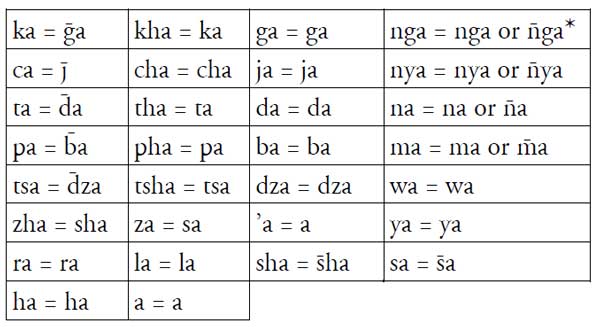
* Nasals (nga, nya, na, ma) in the root position take on a high tone only when affected by a prefixed or superscribed letter.
- The table of contents that is found in volume e of Dl-bo-bas Collected Works separate from and just before the Mountain Doctrine is embedded in the translation; it is given in its entirety ; the numbers in braces indicate the number of subdivisions, and the numbers in parentheses indicate locations in the Gangtok and Dzam thang editions respectively.
- Footnotes are marked a, b, c; backnotes are marked 1, 2, 3. References to texts and translations as well as the Sanskrit of quotations are mostly given in the backnotes, whereas other information pertinent to the reading of the material at hand is given in the footnotes.
- In the footnotes and endnotes references to the Gangtok edition of the Tibetan text of the Mountain Doctrine use the added page numbers, rather than the folio numbers, and thus lack a or b, whereas references to the Dzam thang edition use the folio numbers and thus contain either a or b. Often, only one edition is cited.
- Full bibliographical references are given in the footnotes and backnotes at first citation.
- For translations and editions of texts, see the Bibliography.
- I have translated the term drang don (neyrtha) sometimes as interpretable meaning and other times as requiring interpretation, or a variant thereof. There is no significance to the multiple translations other than variety and clarity.
- The names of Indian Buddhist schools of thought are translated into English in an effort to increase accessibility for non-specialists.
- Contrary to my usual custom the initial letters of names of deities and so forth are not capitalized since these terms often refer to principles.
- For the names of Indian scholars and systems used in the body of the text, ch, sh, and h are used instead of the more usual c, , and for the sake of easy pronunciation by non-specialists; however, cch is used for cch, not chchh. In parentheses the usual transliteration system for Sanskrit is used.
Dl-bo-ba Shay-rap-gyel-tsen,
Without question, the teachings and writing of Dol po pa, who was also known as The Buddha from Dol po (Dol po sangs rgyas), and The Omniscient One from Dol po who Embodies the Buddhas of the Three Times (
Next page
